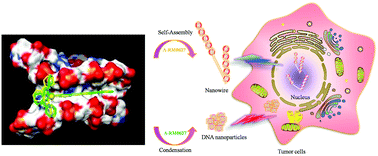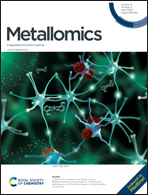Chiral Ru(ii) complexes act as a potential non-viral gene carrier for directional transportation to the nucleus and cytoplasm†
Abstract
Guanine-rich DNA sequences can spontaneously fold into four-stranded structures called G-quadruplexes (G4s). G4s have been identified extensively in the promoter regions of several proto-oncogenes, including c-myc, as well as telomeres. G4s have attracted an increasing amount of attention in the field of nanotechnology because of their use as versatile building blocks of DNA-based nanostructures. In this study, we report the self-assembly of c-myc G-quadruplex DNA controlled by a pair of chiral ruthenium(II) complexes coordinated by 2-(4-phenyacetylenephenyl)-1H-imidazo[4,5f][1,10]phenanthroline (PBEPIP), Λ-[Ru(bpy)2(PBEPIP)](ClO4)2 (Λ-RM0627, bpy = bipyridine) and Δ-[Ru(bpy)2(PBEPIP)](ClO4)2 (Δ-RM0627). Λ-RM0627 could promote the high-order self-assembly of c-myc G-quadruplex DNA into a nanowire structure, whereas Δ-RM0627 could induce DNA condensation into G-quadruplex aggregates. Moreover, in vitro studies on human liver carcinoma HepG2 cells showed that the nanowire of c-myc G-quadruplex DNA promoted by Λ-RM0627 could be localized in the nuclei of cells, whereas the nanoparticle of c-myc G-quadruplex DNA generated by Δ-RM0627 was taken up and localized in the cytoplasm. This study provides examples of the enantioselective self-assembly of G4 DNA molecules controlled by chiral ruthenium(II) complexes and suggests the potential applications of assembled nanostructures as non-viral DNA vectors for gene therapy.



 Please wait while we load your content...
Please wait while we load your content...